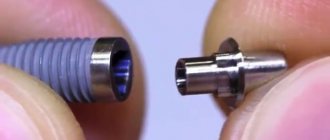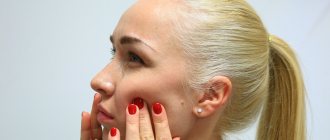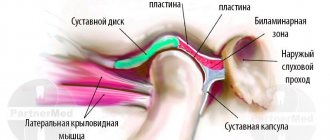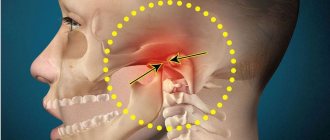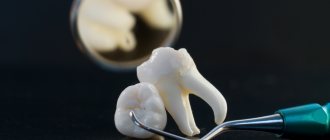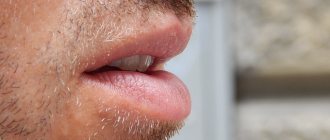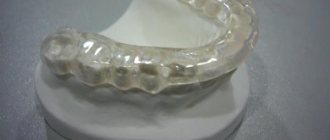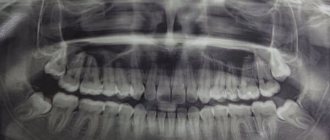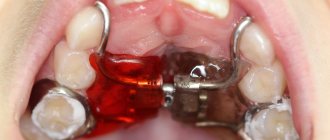The TMJ is a temporomandibular facial joint, characterized by high functionality and subject to constant increased loads. One of the most common and complex diseases affecting this joint is arthrosis. The peculiarities of the treatment are that therapeutic measures are carried out not only by an experienced dentist; psychologists and traumatologists also participate in the treatment.
TMJ dysfunction, the treatment of which takes quite a long time, is successfully carried out at the Denta Lex dental clinic, where specialists with extensive experience and work experience provide consultations. Impaired functionality of this joint causes the development of many diseases, not excluding diseases of the digestive system. After all, it is the condition of the TMJ that determines how well such a function as chewing is performed, and the quality of further processing and assimilation of food also depends on it.
Arthrosis of the TMJ - the occurrence and development of the disease
Arthrosis of the TMJ, its treatment and diagnosis, the choice of therapeutic measures and restorative procedures - all this has been the subject of controversy and discussion among many famous doctors for many years. Not all dental clinics have specialists ready to provide therapy for this disease, but the Denta Lex clinic has created all the necessary conditions to provide complete and effective care to patients who come here.
The peculiarity of the disease is that it is quite difficult to accurately diagnose. To conduct a detailed examination, it is necessary to use the most modern equipment. Doctors at the Denta Lex clinic will confirm or cancel the preliminary diagnosis after the patient passes:
- ultrasonography;
- magnetic resonance imaging;
- radiography.
All types of instrumental examinations produce results that only an experienced doctor can read correctly. This is due to the nature of the disease itself. Arthrosis is a process during which rapid destruction of the joint occurs, in the complete absence of inflammation. The danger lies in the fact that at the initial stage of the disease the patient does not feel pain or significant discomfort, and therefore most patients go to the doctor at a time when the disease is already advanced.
When selecting treatment for TMJ, dentists base their decision on the degree of destruction of the joint at the time of seeking medical help. Destruction in the joint leads to:
- to violation of disk integrity;
- deformations;
- the appearance of pain;
- difficulty chewing.
In the most advanced cases, the degenerative process can affect the bone. Destruction and deformation of the joint lead to the disruption of its main function. But no less dangerous is the fact that with arthrosis, the main articular tissue is replaced by connective tissue. It is denser and tougher, but much less elastic. In this case, not only the chewing function, but also the speaking function, which the temporomandibular joint must perform, is disrupted.
Features of arthrosis of the temporomandibular joint
MBST therapy is also indispensable in the treatment of arthrosis, which affects the temporomandibular joint (TMJ), which ensures the movement of the lower jaw (opening the mouth, moving to the side), without which it would be impossible to chew food and pronounce sounds. When the jaw joint is damaged, its surface becomes thinner, which leads to impaired mobility, and pain appears when displaced.
If you do not provide timely assistance or try to be treated with various folk remedies, the patient’s chronic inflammatory process will progress.
The symptoms of the disease are quite pronounced: pain that occurs when the joint is loaded (chewing), and is felt on one side, as well as a characteristic crunching sound, limited mouth opening, and sometimes decreased hearing.
Among the factors associated with the appearance of arthrosis of the jaw are age over 50 years, previous operations on the temporal and jaw joints, injuries, lack of teeth, heredity, and inflammatory processes affecting other joints in the body.
Types of TMJ arthrosis
Doctors distinguish two main types of TMJ arthrosis:
- deforming;
- sclerosing.
Deforming occurs in the process of proliferation of connective tissue. In this case, the mobility of the joint decreases or completely disappears, the angle of attachment of the lower jaw changes and obvious deformation appears.
Sclerosing is different in that the joint does not lose its original shape, but due to sclerotic plaques it becomes almost immobile. In this case, the patient experiences significant difficulties both while eating and when communicating with other people.
Depending on the type of TMJ, treatment is aimed at restoring joint mobility, but in one case it is necessary to eliminate inflammation, and in the second it is necessary to carry out therapeutic measures aimed at combating sclerosis.
Reasons for the development of the disease
There are quite a few reasons why a person faces such a problem as the occurrence of arthrosis of the temporomandibular joint:
- disruption of the functionality of the endocrine system leads to the development of this disease;
- infectious diseases or complications after them;
- heart and vascular diseases;
- neurocirculatory diseases;
- osteoporosis and muscular dystrophy.
There are also local factors, the negative impact of which affects the condition and functionality of the TMJ. We are talking about situations such as:
- trauma leading to joint damage;
- inflammatory process causing arthritis;
- edentia or lack of timely competent treatment of molars;
- malocclusion;
- constant or periodic increased load placed on the lower jaw.
Traumatic damage to the joint causes the development of a sclerosing form of the disease, but previous diseases or the presence of such ailments as arthrosis, arthritis, osteoporosis and others become the cause of the occurrence and development of deforming arthrosis of the temporomandibular joint.
Reasons for development
The causes of TMJ arthrosis are various factors, including:
- chronic arthritis;
- presence of malocclusion;
- partial edentia (usually caused by loss of lower molars);
- incorrect prosthetics or incorrect installation of fillings;
- the presence of injuries or operations in the temporomandibular joint;
- genetic predisposition;
- vascular, infectious, endocrinological diseases;
- hormonal imbalances (in women).
Clinical picture
The first manifestations of dysfunction of the TMJ are associated with the appearance of a feeling of discomfort when trying to open the mouth wide. The patient does not yet complain of pain, but already notices that it is difficult for him to yawn or bite off a large piece. After some time, there is a feeling that one of the parts of the joint is caught on something and this prevents it from moving, but after a click everything falls into place and mobility is restored.
Such clicks and crunches in the joint are a sign of the second stage of the disease. Later, pain will be added to the already familiar feeling of discomfort and difficulty moving in the joint. Unpleasant and even painful sensations arise while eating or during communication with other people. It becomes difficult for the patient to chew, laugh, or simply talk. Every movement is accompanied by more and more noticeable pain.
Then comes the moment when a person practically cannot open his mouth. The slightest movement of the lower jaw causes severe pain. What form of the disease (acute or chronic) will be diagnosed depends on the time interval between the appearance of mild discomfort and the onset of the first severe pain. In the acute form, this interval is minimal, but in the chronic form it can be several years.
According to doctors, the course of the disease can be recognized as acute if the process has developed in no more than 3 months, subacute - if it develops within 6 months. But if the disease lasts and develops for about a year or more, then this form of the disease will be considered chronic.
Now we will look at TMJ diseases in more detail.
TMJ dysfunctions are usually divided according to the type of structures affected:
- Disorders of the masticatory muscles
- Disorders of the joint itself.
All disorders of the masticatory muscles manifest themselves differently. There are 5 different types known. It is important to be able to recognize them because the treatment for each disorder is quite different. These 5 types are:
Protective co-contraction (muscle splinting) is a state of reflexive muscle contraction to protect the injured area. May occur due to:
- Severely interfering filling or crown
- Presence of trauma in the jaw joint
- Increased emotional stress
Local muscle soreness. Usually occurs with prolonged and excessive functioning of the masticatory muscles.
Myofascial pain (trigger point pain) occurs when the central nervous system is highly active.
Myospasm is a sharp contraction of muscles that occurs with a general lack of microelements, calcium, potassium.
Central myalgia. Continuous muscle pain is mainly caused by chronic stress and high activity of the central nervous system.
Disorders of the TMJ itself are probably the most common problems that are visible when examining a patient with chewing dysfunction. The reason for this is the high prevalence of signs (not necessarily symptoms) such as clicking in the joints even in the absence of pain. Consequently, the patient may not seek treatment.
When pain symptoms occur, patients fall into 3 broad categories:
Violation of the relationship between the disc and condyle in the joint.
There are three types of violations:
- A slipped disc is a reversible condition that occurs when there is a malocclusion, usually following a recently treated tooth.
- Disc dislocation with reduction – occurs after an injury or from prolonged displacement of a disc in a joint.
- Disc dislocation without reduction is an advanced form of disc displacement, in this case the opening of the mouth is sharply limited.
Incompatibility of articular elements - with significant wear of the articular discs, a change in the articular surfaces themselves occurs.
There are 4 forms:
- Violation of form
- Formation of adhesions due to depletion of intra-articular fluid reserves
- Involuntary dislocations. When the intra-articular ligaments are severely stretched, they no longer limit jaw movement within normal limits.
- Subluxation. The so-called hypermobility of the joint, when the patient can open his mouth wider than the prescribed 33-55 mm
Inflammatory joint diseases.
These include:
- Synovitis, Capsulitis – inflammation of the joint membrane;
- Retrodiscitis - inflammation of the posterior disc fatty tissue of the joint;
- Osteoarthritis is an inflammatory process that changes the bony articular surfaces of the condyle and fossa.
Long-term untreated TMJ diseases lead to the appearance of arthrosis. Unfortunately, a limited number of clinics provide treatment for arthrosis in Moscow. Doctors at our clinic have effective methods of treating arthrosis, such as splint therapy, muscle deprogramming, and rational prosthetics taking into account the patient’s data.
Temporomandibular joint dysfunction is a disease that is currently treated by a limited number of gnathologists. Although any dental treatment, even minimal, should be carried out taking into account the patient’s TMJ data.
Causes of TMJ dysfunction
- Injuries.
- Excessive mouth opening.
- Bruxism and teeth grinding.
- Excessive consumption of hard and tough foods.
- General somatic disorders in connective and bone tissue.
- Malocclusion.
Temporomandibular joint dysfunction syndrome
Temporomandibular joint dysfunction
In fact, not entirely correct placement of even one filling, without taking into account the existing occlusal relationships, can lead to the development of symptoms of dysfunction:
- Crunches and clicks in the TMJ.
- Pain in the face and head.
- Lack of stable bite.
- Hypersensitivity in teeth.
- “Ear symptoms” are noises and pain in this area.
- Moving the jaw to the side when opening.
The study of temporomandibular joint dysfunction consists of:
- Initial examination and consultation with a specialist;
- CT scan or preferably MRI of joints with description;
- Functional analysis of the dentofacial system.
Headache due to TMJ
After examining the TMJ and collecting diagnostic data, the gnathologist selects a treatment method and tactics. There are three approaches:
Conservative treatment of temporomandibular joint dysfunction in Moscow.
Conservative treatment methods include wearing removable orthopedic mouth guards, plates and devices, with the help of which symptoms such as pain go away, the click disappears, and the healthy state of the TMJ is restored. Also, as part of conservative treatment, various drugs can be prescribed that reduce inflammation in the joint tissues and reduce the tone of the masticatory muscles.
Reconstructive treatment of TMJ dysfunction in Moscow consists of changing the position of the lower jaw using various orthopedic structures:
- Crowns;
- Veneers;
- Lumineers;
- Ceramic linings;
- Composite fillings;
- Correction of bite with braces.
Before reconstructive treatment, treatment with mouth guards and temporary structures is always carried out to practice the correct bite and the correct position of the elements of the TMJ.
Surgical treatment of TMJ involves plastic surgery of the joint or replacement of the articular disc with an artificial one; it is also possible to inject drugs into the joint cavity. Such intervention is necessary in extreme cases of disease development.
Diagnosis and treatment of TMJ athrosis in Altufyevo dentistry
After seeking help from a dental clinic, the patient will be sent for an examination, during which he will need to undergo clinical tests to determine the presence of an inflammatory process in the body. In order to identify dysfunction and prescribe treatment for TMJ, it is necessary to obtain the results of an instrumental examination. Therefore, the doctor gives the patient a referral for:
- ultrasonography;
- magnetic resonance imaging;
- three-dimensional radiography;
- CT.
After receiving the results, specialists can make an accurate diagnosis and select treatment for each specific case of TMJ arthrosis that corresponds to the stage of development of the disease and the degree of the inflammatory process. Of course, when choosing tactics and methods for carrying out therapeutic measures, doctors at the Denta Lex clinic take into account the individual characteristics of each patient.
Therapy is based on eliminating the cause of the disease. First of all, the doctor will take measures to stop the inflammatory process and relieve the patient of severe pain. Once TMJ arthrosis has been diagnosed, treatment is aimed at restoring the basic function of the joint.
The goal of treating TMJ with arthrosis is the need to stop the process of joint destruction, restore mobility and prevent further development of the pathological process. That is why the chosen methods include TMJ treatment:
- non-medicinal.
- medicinal;
Drug therapy involves the prescription of potent analgesics that help a person get rid of severe, excruciating pain. It is necessary to prescribe and use anti-inflammatory drugs and antipyretics. During the treatment of TMJ, patients receive muscle relaxants and sedatives, and in the most difficult cases they receive intra-articular injections.
Contacting the Denta Lex clinic
In order to find out in detail what products the doctors at the Denta Lex clinic use to treat TMJ, and what price you will need to pay for therapeutic measures, just contact the clinic using the phone numbers listed on the website. During the telephone conversation, the operator will answer all questions that arise. This way you will be able to clarify not only the price, but also the duration of therapy, features of the procedure, find out the level of qualifications of the doctor and take advantage of the opportunity to make an appointment in advance.
The peculiarity of treatment at the Denta Lex clinic is that it is based on an individual approach to solving the existing problem. The most modern equipment is installed here for instrumental examination and other procedures. All therapeutic measures are carried out at the modern level with the prescription of effective medications.
Before the patient undergoes completely safe and painless, but very effective procedures, doctors will accurately determine the essence of the problem, which will allow it to be solved with the highest quality and in the shortest possible time.


